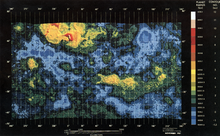Ishtar Terra
Template:Infobox feature on Venus

Ishtar Terra is one of two main highland regions on the planet Venus. It is the smaller of the three "continents", and is located near the north pole. It is named after the Akkadian goddess Ishtar.
The size of Ishtar Terra is roughly between the sizes of Australia and the continental United States. On its eastern edge lies the great mountain chain Maxwell Montes, which is 11 km high, compared to Mt. Everest at 8.8 km. On one side of the mountain chain is an impact crater of 100 km in diameter filled with lava. [citation needed]
Ishtar Terra contains the four main mountain ranges of Venus: Maxwell Montes on the eastern edge, Freyja Montes in the north, Akna Montes on the western edge, and Danu Montes in the southern region. These surround the lower plain of Ishtar Terra, which is named Lakshmi Planum (named after the Hindu goddess Lakshmi).
Ishtar Terra also contains volcanoes named after famous women: Sacajawea, Colette, and Cleopatra. Ishtar Terra is also the site of many tesserae, formed by tectonic deformation.[citation needed]
See also
- Geography of Venus
- Note that Ishtar Terra is located near the south pole if Venus's rotation is defined as prograde by the right-hand rule.[citation needed] The rotation of the planet is commonly characterized as retrograde in order to correlate its northern hemisphere with Earth's, in which case Ishtar Terra is near the north pole. This is the convention normally used for maps.
External links
- "Ishtar Terra". Gazetteer of Planetary Nomenclature. USGS Astrogeology Research Program.
- IRISP Research Projects http://irsps.sci.unich.it/research/projects/venus/ishtar/
- WPT http://pds.jpl.nasa.gov/planets/captions/venus/perspect.htm
- Funky Science http://www.funkyscience.net/imagebank/channel_ishtar.html
- NASA Map of Venus:
